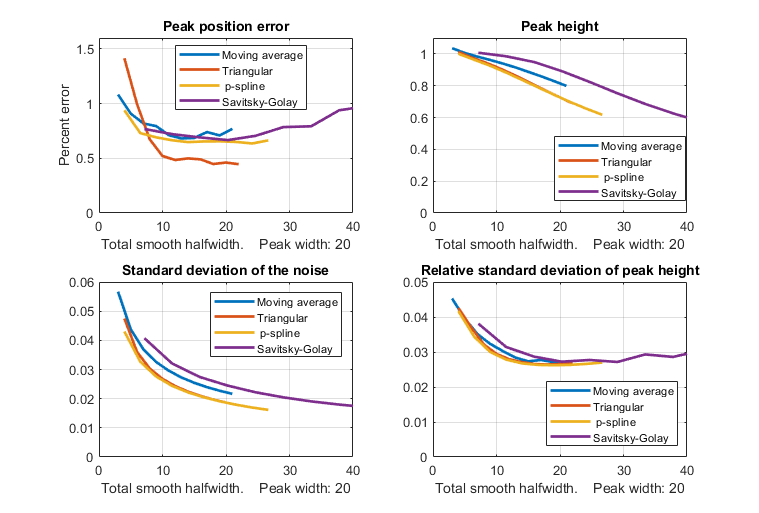
The Matlab/Octave function "MultiPeakOptimization.m" is a self-contained function that compares
the performance of four types of linear smooth operations: (1)
sliding-average rectangular, (2) triangular, (3) p-spline
(equivalent to three passes of a sliding-average), and (4)
Savitzky-Golay. These are the four smooth types discussed above,
corresponding to the four values of the "SmoothMode" input
argument of the ProcessSignal and the interactive iSignal functions. These four smooth
operations are applied to a 18000-point signal consisting of 181
Gaussian peaks with a height of 1.0 and a FWHM (full-width
at half-maximum) of 20 points
("wid"), line 10), which are all separated by an x-value of
160.01 (line 16), plus added noise consisting of
normally-distributed random white noise
The four quadrants of the graph are: (upper
left) peak position error expressed as a percentage of the peak
separation; (upper right), the mean peak height of the smoothed
peaks; (lower left), the standard deviation of the smoothed
noise; and (lower right) the relative standard deviation of the
measured peak heights. The different smooth types are indicated
by color: blue - sliding-average; red - triangular; yellow -
p-spline, and purple - Savitzky-Golay.
These results show that the
results of these different smooth types are quite similar but
that, the Savitzky-Golay smooth gives the smallest reduction in
peak height but the smallest reduction in noise amplitude,
compared to the other methods. All these smoothing methods
result in similar improvements in the standard deviation of the
peak height (bottom right panel) and in the peak position error
(upper left panel). Moreover, in all cases, the optimum
performance is achieved when the total smooth width is
approximately equal to the halfwidth of the peak. The
conclusions are the same for a Lorentzian peak, as demonstrated
by a similar function "MultiPeakOptimizationLorentzian.m", graphic, the difference being that the peak height
reduction is greater for the Lorentzian. For applications where
the shape of the signal must be preserved as much as possible,
the Savitzky-Golay is the method of choice. In peak
detection applications (page 221), on the other hand, where the purpose of
smoothing is to reduce the noise in the derivative signal, the
retention of the shape of that derivative is less important
because peak parameters are determined by least-squares fitting.
Therefore, the triangular or p-spline smooth is well suited to
this purpose and can be faster for very large smooth widths.
The differences between these methods is even less when the abcissa in the above graph is changed from total smooth bandwidth to noise reduction factor, defined as the square root of the reciprocal of the sum of the square of the impulse response function, as shown in figure window 3.

